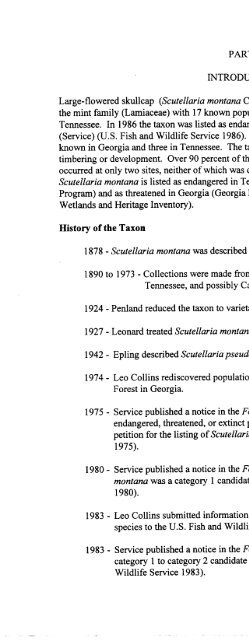Large-flowered Skullcap Recovery Plan - U.S. Fish and Wildlife ...
Large-flowered Skullcap Recovery Plan - U.S. Fish and Wildlife ...
Large-flowered Skullcap Recovery Plan - U.S. Fish and Wildlife ...
You also want an ePaper? Increase the reach of your titles
YUMPU automatically turns print PDFs into web optimized ePapers that Google loves.
PART I<br />
INTRODUCTION<br />
<strong>Large</strong>-<strong>flowered</strong> skullcap (Scutellaria montana Chapman) is an herbaceous representative of<br />
the mint family (Lamiaceae) with 17 known populations in northern Georgia <strong>and</strong> southeastern<br />
Tennessee. In 1986 the taxon was listed as endangered by the U.S. <strong>Fish</strong> <strong>and</strong> <strong>Wildlife</strong> Service<br />
(Service) (U.S. <strong>Fish</strong> <strong>and</strong> <strong>Wildlife</strong> Service 1986). At that time, there were seven populations<br />
known in Georgia <strong>and</strong> three in Tennessee. The taxon was threatened by habitat loss due to<br />
timbering or development. Over 90 percent ofthe 7,000 individual plants known in 1986<br />
occurred at only two sites, neither ofwhich was completely protected from known threats.<br />
Scutellaria montana is listed as endangered in Tennessee (Tennessee Natural Heritage<br />
Program) <strong>and</strong> as threatened in Georgia (Georgia Department ofNatural Resources, Freshwater<br />
Wetl<strong>and</strong>s <strong>and</strong> Heritage Inventory).<br />
History of the Taxon<br />
1878 - Scutellaria montana was described by Chapman (1878).<br />
1890 to 1973 - Collections were made from several sites, including Hamilton County,<br />
Tennessee, <strong>and</strong> possibly Catoosa County, Georgia.<br />
1924 - Penl<strong>and</strong> reduced the taxon to varietal status (Penl<strong>and</strong> 1924).<br />
1927 - Leonard treated Scutellaria montana at specific rank (Leonard 1927).<br />
1942 - Epling described Scutellariapseudoserrata as distinct from Scutellaria montana.<br />
1974 - Leo Collins rediscovered populations of Scutellaria montana in the Marshall<br />
Forest in Georgia.<br />
1975 - Service published a notice in the Federal Register accepting a report on<br />
endangered, threatened, or extinct plants by the Smithsonian Institution as a<br />
petition for the listing ofScutellaria montana (U.S. <strong>Fish</strong> <strong>and</strong> <strong>Wildlife</strong> Service<br />
1975).<br />
1980 - Service published a notice in the Federal Register indicating Scutellaria<br />
montana was a category 1 c<strong>and</strong>idate species (U.S. <strong>Fish</strong> <strong>and</strong> <strong>Wildlife</strong> Service<br />
1980).<br />
1983 - Leo Collins submitted information gathered from several years of research on the<br />
species to the U.S. <strong>Fish</strong> <strong>and</strong> <strong>Wildlife</strong> Service.<br />
1983 - Service published a notice in the Federal Register indicating a change from<br />
category 1 to category 2 c<strong>and</strong>idate for Scutellaria montana ( U.S. <strong>Fish</strong> <strong>and</strong><br />
<strong>Wildlife</strong> Service 1983).

















